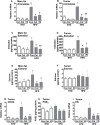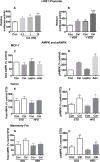Vitamin D mitigates the adverse effects of obesity on breast cancer in mice
- PMID: 26817629
- PMCID: PMC4889430
- DOI: 10.1530/ERC-15-0557
Vitamin D mitigates the adverse effects of obesity on breast cancer in mice
Abstract
Obesity is an established risk factor for postmenopausal breast cancer (BCa), insulin resistance, and vitamin D deficiency, and all contribute to increased synthesis of mammary estrogens, the drivers of estrogen receptor-positive (ER+) BCa growth. As both dietary vitamin D and calcitriol treatments inhibit breast estrogen synthesis and signaling, we hypothesized that vitamin D would be especially beneficial in mitigating the adverse effects of obesity on ER+BCa. To assess whether obesity exerted adverse effects on BCa growth and whether vitamin D compounds could reduce these unfavorable effects, we employed a diet-induced obesity (DIO) model in ovariectomized C57BL/6 mice. Breast tumor cells originally from syngeneic Mmtv-Wnt1 transgenic mice were then implanted into the mammary fat pads of lean and obese mice. DIO accelerated the initiation and progression of the mammary tumors. Treatments with either calcitriol or dietary vitamin D reduced the adverse effects of obesity causing a delay in tumor appearance and inhibiting continued tumor growth. Beneficial actions of treatments with vitamin D or calcitriol on BCa and surrounding adipose tissue included repressed Esr1, aromatase, and Cox2 expression; decreased tumor-derived estrogen and PGE2; reduced expression of leptin receptors; and increased adiponectin receptors. We demonstrate that vitamin D treatments decreased insulin resistance, reduced leptin, and increased adiponectin signaling and also regulated the LKB1/AMPK pathway contributing to an overall decrease in local estrogen synthesis in the obese mice. We conclude that calcitriol and dietary vitamin D, acting by multiple interrelated pathways, mitigate obesity-enhanced BCa growth in a postmenopausal setting.
Keywords: adipokines; aromatase; breast cancer; obesity; vitamin D.
© 2016 Society for Endocrinology.
Conflict of interest statement
R. L. Horst has an ownership interest in Heartlands Assays LLC. The other authors declare that there is no conflict of interest that could be perceived as prejudicing the impartiality of the research reported.
Figures
Similar articles
-
The potential therapeutic benefits of vitamin D in the treatment of estrogen receptor positive breast cancer.Steroids. 2012 Sep;77(11):1107-12. doi: 10.1016/j.steroids.2012.06.005. Epub 2012 Jul 16. Steroids. 2012. PMID: 22801352 Free PMC article. Review.
-
Omega-3-Acid Ethyl Esters Block the Protumorigenic Effects of Obesity in Mouse Models of Postmenopausal Basal-like and Claudin-Low Breast Cancer.Cancer Prev Res (Phila). 2015 Sep;8(9):796-806. doi: 10.1158/1940-6207.CAPR-15-0018. Epub 2015 Jun 22. Cancer Prev Res (Phila). 2015. PMID: 26100521 Free PMC article.
-
Inhibition of Mouse Breast Tumor-Initiating Cells by Calcitriol and Dietary Vitamin D.Mol Cancer Ther. 2015 Aug;14(8):1951-61. doi: 10.1158/1535-7163.MCT-15-0066. Epub 2015 May 1. Mol Cancer Ther. 2015. PMID: 25934710 Free PMC article.
-
A nude mouse model of obesity to study the mechanisms of resistance to aromatase inhibitors.Endocr Relat Cancer. 2015 Aug;22(4):645-56. doi: 10.1530/ERC-15-0168. Epub 2015 Jun 25. Endocr Relat Cancer. 2015. PMID: 26113604
-
Vitamin D and breast cancer: inhibition of estrogen synthesis and signaling.J Steroid Biochem Mol Biol. 2010 Jul;121(1-2):343-8. doi: 10.1016/j.jsbmb.2010.02.009. Epub 2010 Feb 13. J Steroid Biochem Mol Biol. 2010. PMID: 20156557 Review.
Cited by
-
Metabolic pathways in obesity-related breast cancer.Nat Rev Endocrinol. 2021 Jun;17(6):350-363. doi: 10.1038/s41574-021-00487-0. Epub 2021 Apr 29. Nat Rev Endocrinol. 2021. PMID: 33927368 Free PMC article. Review.
-
Vitamin D in Cancer Prevention and Treatment: A Review of Epidemiological, Preclinical, and Cellular Studies.Cancers (Basel). 2024 Sep 20;16(18):3211. doi: 10.3390/cancers16183211. Cancers (Basel). 2024. PMID: 39335182 Free PMC article. Review.
-
Targeting nuclear hormone receptors for the prevention of breast cancer.Front Med (Lausanne). 2023 Jul 31;10:1200947. doi: 10.3389/fmed.2023.1200947. eCollection 2023. Front Med (Lausanne). 2023. PMID: 37583424 Free PMC article. Review.
-
Vitamin D supplementation decreases serum 27-hydroxycholesterol in a pilot breast cancer trial.Breast Cancer Res Treat. 2018 Feb;167(3):797-802. doi: 10.1007/s10549-017-4562-4. Epub 2017 Nov 7. Breast Cancer Res Treat. 2018. PMID: 29116467 Free PMC article. Clinical Trial.
-
Vitamin D, Th17 Lymphocytes, and Breast Cancer.Cancers (Basel). 2022 Jul 27;14(15):3649. doi: 10.3390/cancers14153649. Cancers (Basel). 2022. PMID: 35954312 Free PMC article. Review.
References
-
- Ahn J, Schatzkin A, Lacey JV, Jr, Albanes D, Ballard-Barbash R, Adams KF, Kipnis V, Mouw T, Hollenbeck AR, Leitzmann MF. Adiposity, adult weight change, and postmenopausal breast cancer risk. Arch Intern Med. 2007;167:2091–2102. - PubMed
-
- Berstein LM, Kovalevskij AY, Poroshina TE, Kotov AV, Kovalenko IG, Tsyrlina EV, Leenman EE, Revskoy SY, Semiglazov VF, Pozharisski KM. Signs of proinflammatory/genotoxic switch (adipogenotoxicosis) in mammary fat of breast cancer patients: role of menopausal status, estrogens and hyperglycemia. Int J Cancer. 2007;121:514–519. - PubMed
-
- Boonchaya-anant P, Holick MF, Apovian CM. Serum 25-hydroxyvitamin D levels and metabolic health status in extremely obese individuals. Obesity (Silver Spring) 2014;22:2539–2543. - PubMed
-
- Bradford MM. A rapid and sensitive method for the quantitation of microgram quantities of protein utilizing the principle of protein dye binding. Anal Biochem. 1976;72:248–254. - PubMed
Publication types
MeSH terms
Substances
Grants and funding
LinkOut - more resources
Full Text Sources
Other Literature Sources
Medical
Research Materials
Miscellaneous







